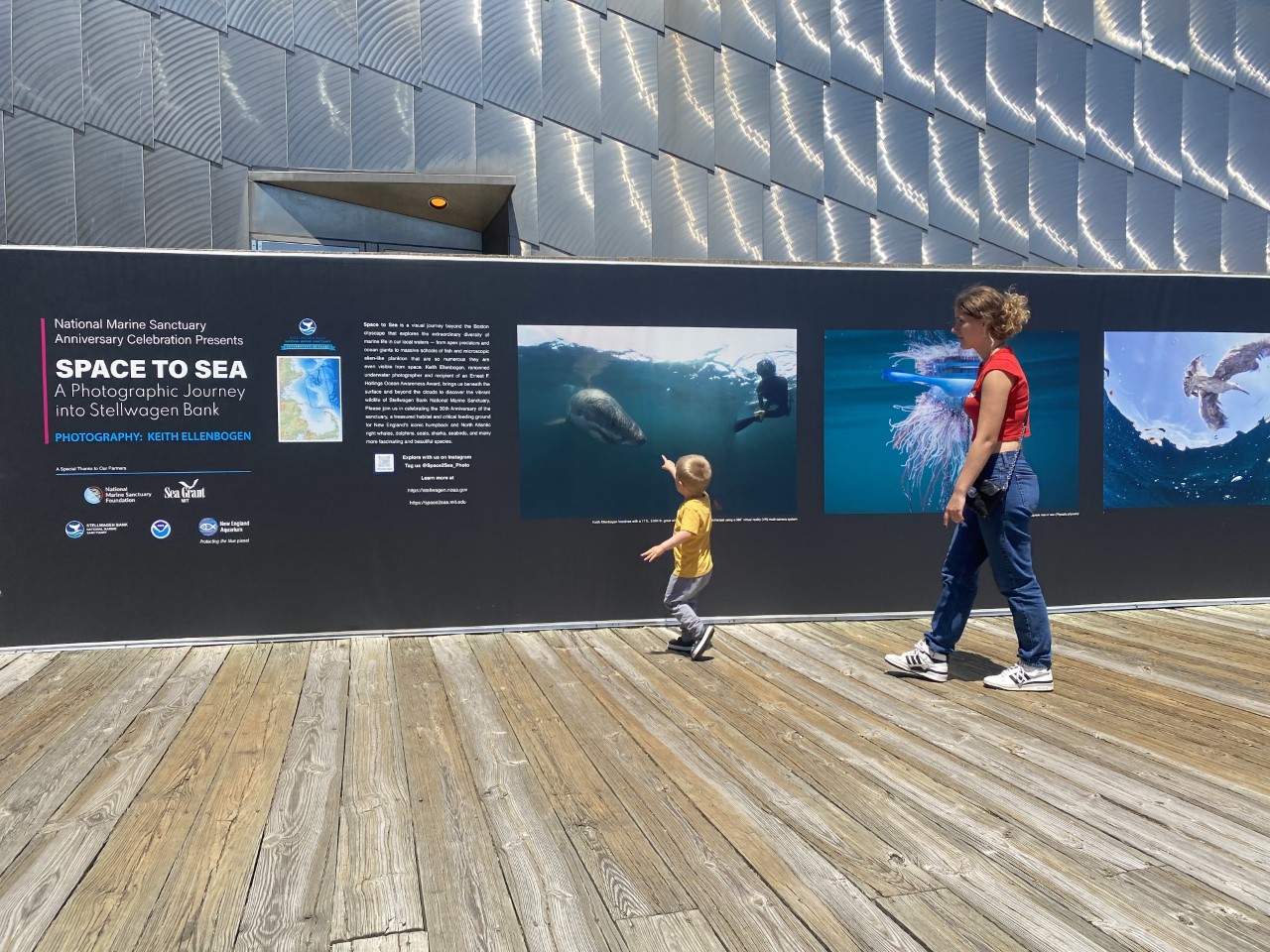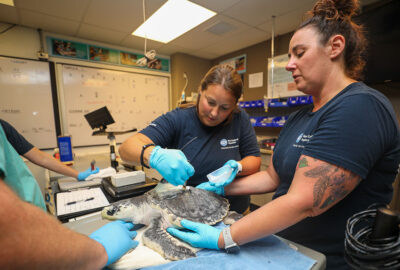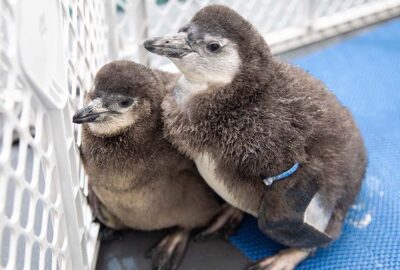Space to Sea Photography Exhibit Shows Viewers Deep Sea Life
By New England Aquarium on Wednesday, August 03, 2022

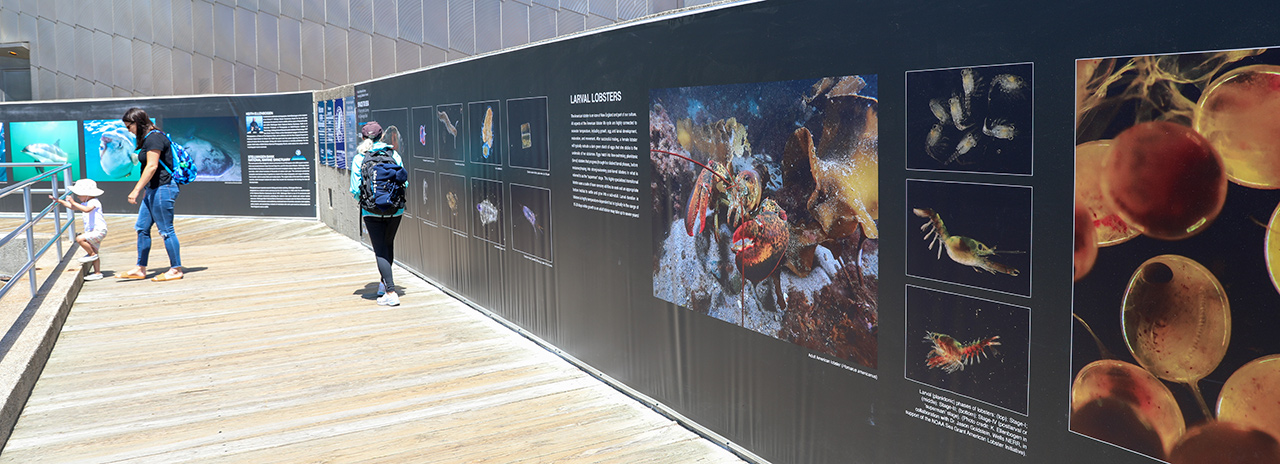
Along the wooden boardwalk of Central Wharf, images depicting the fluttering tentacles of a bluebottle jellyfish, encircling sharks, and a humpback whale slicing through the ocean’s surface wrap around the New England Aquarium and its Simons Theatre. The photos—by acclaimed underwater photographer Keith Ellenbogen—are part of Space to Sea: A Photographic Journey into Stellwagen Bank National Marine Sanctuary on view through November 1. The free, public exhibition features more than 50 dynamic images, including close-ups of majestic great white sharks, wading seals, and mola mola. Ellenbogen will also host artist walks that are open to the public.
“Space to Sea” is made possible through a grant from the National Marine Sanctuary Foundation. The exhibit is a collaboration of the National Oceanic and Atmospheric Administration’s Stellwagen Bank National Marine Sanctuary; the MIT Sea Grant Program at the Massachusetts Institute of Technology; the National Marine Sanctuary Foundation; and the New England Aquarium.
The Stellwagen Bank National Marine Sanctuary, established thirty years ago, is east of Boston between Cape Ann and Cape Cod. A historic fishing ground, Stellwagen is New England’s only national marine sanctuary and is also a whale watching destination that still supports commercial and recreational fishing.
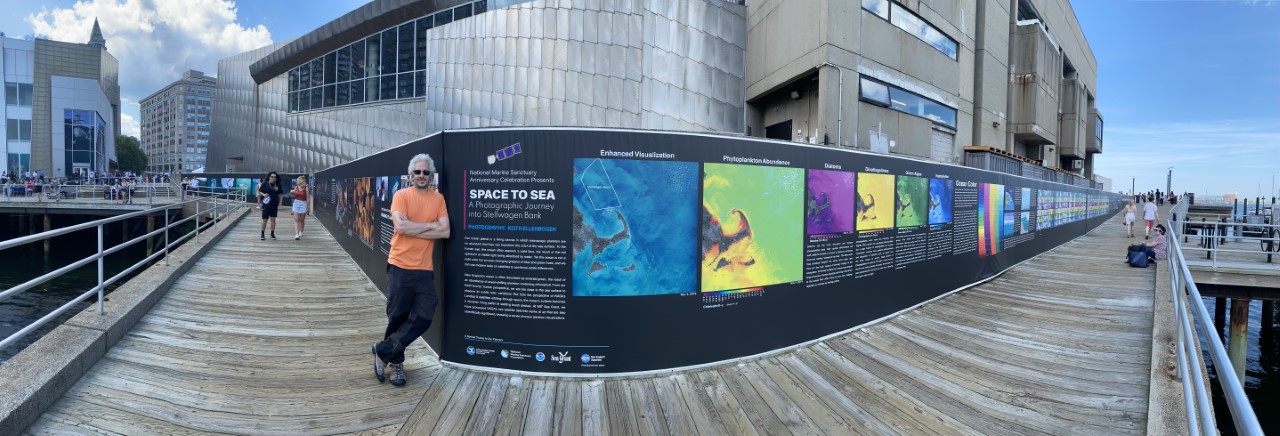
Ellenbogen, who used to volunteer at the Aquarium in high school, has been snapping pictures of sea life worldwide for more than 20 years and his photos have been featured in several Aquarium ad campaigns over the years. Through his work, he aspired to connect people to the animals in the ocean, a world that many will never see.
“The sanctuary is 25 miles off the coast, so you need a boat to get there, and it’s underwater. So, the majority of people don’t have an opportunity to experience the marine life off our coast,” Ellenbogen shared.
James Sutherland, associate vice president of public policy and advocacy at the Aquarium, agrees.
“Prior to working here, I wasn’t aware of the sanctuary. Now, Keith’s exciting work showcases some of the habitats and species existing in our backyard that many people don’t have access to,” he says.
Despite the distance from the shore and the water’s murky but nutrient-dense conditions, it hasn’t prevented Ellenbogen from capturing awe-inspiring shots in the underwater sanctuary. Ellenbogen’s day starts early in the morning, around 3:30 a.m., when diving, and he can easily spend 10-12 hours in and out of the water before heading home around 8:00 p.m. It takes a “couple of hours to clean and prep the gear on both sides of the dive,” he says.
Underwater photography is a time-consuming and laborious project that he’s passionate about.
Though he doesn’t see animals on every dive, when he does, Ellenbogen searches and observes, seeking the moment where all elements come together compellingly. He’s addicted to the allure of discovery, and with his camera in hand, Ellenbogen enjoys moving “in three-dimensional spaces instead of two-dimensional. Underwater, I can move up, down, left, right.”
The marine environment forces him to “be aware of [his] movement, lighting, and breathing.”
In fact, one (of many) of Ellenbogen’s most exciting moments occurred with a humpback whale. After getting the National Oceanic Atmospheric Association’s marine mammal photography permit to dive with them, Ellenbogen says, “I had an interaction with a juvenile humpback whale, which I subsequently named Junior Mint, who was incredibly curious and would swim underneath and around me.”
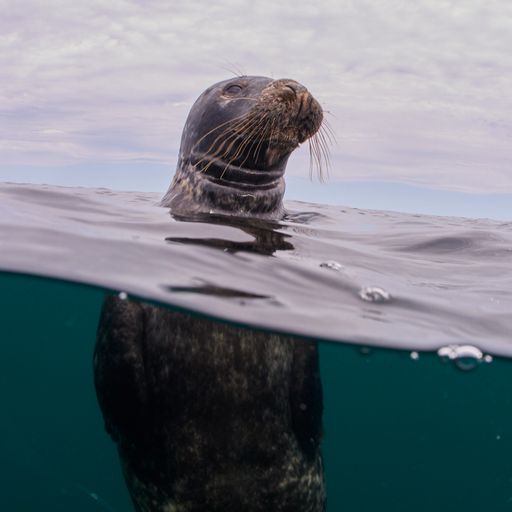
Gray seal. Photo courtesy of Keith Ellenbogen.
Junior Mint seemed as interested in him as he was in it, Ellenbogen says, and the two spent about 30 minutes together.
“It would just sort of hover at the distance of visibility, and we’d stare at each other. It’s such a big animal, it was incredible, and I could feel its presence there,” he explains. “Then for a brief moment, the whale approached close enough for a compelling picture.”
That sense of wonder, intimacy, and inspiration is what Ellenbogen hopes to convey with Space to Sea.
He tries to highlight the animals’ colors and texture, how they swim, and more in a way that onlookers can connect to. Ellenbogen wants his photos to convey that there’s a relationship either with eye contact, body movement, or gesture, he says.
Ellenbogen hopes that by communicating the body language of various marine animals, his work will evoke a sense of curiosity and empathy that acts as an inspiration for ocean stewardship.
And his efforts are proving fruitful.
A recipient of the Ernest F. Hollings Ocean Awareness Award, Ellenbogen’s work showcases the dynamic marine wildlife off the coast of Massachusetts and within Stellwagen Bank National Marine Sanctuary in honor of its 30-year anniversary.
These connections that Ellenbogen—a visiting artist at the Massachusetts Institute of Technology, MIT Sea Grant program—aims to cultivate through photography happen on and off the water. For example, the images in the exhibit, Lily Keyes—MIT Sea Grant’s communication specialist—says, directly link to MIT’s work.
“One of our focus areas is environmental literacy, so [the work is] acting as the bridge between the research and engineering that goes on in our program and at MIT and connects it with people who may not have as much direct access or understanding,” Keyes explains.
She also notes that Ellebogen’s work helps visualize MIT Sea Grant efforts in evolving areas like coastal resilience, capturing aerial views of shellfish farms and restoration and below-the-surface shots of eelgrass beds that prevent erosion and store carbon.
In addition to the larger marine animals, Ellenbogen’s exhibit also captured teeny things like the eggs and larvae of lobsters as well as an array of planktonic animals.
For Keyes, a former underwater photographer who spent time taking pictures of marine life in Mozambique, the photos of microscopic plankton are her favorite.
“It’s incredible when you think about how a huge animal like [a basking shark] is surviving largely on billions of little, microscopic plankton,” Keyes says. “It’s an interesting juxtaposition to have those photos in the same exhibit as apex predators.”
Keyes says, “It’s a full circle moment.”
Space to Sea: A Photographic Journey into Stellwagen Bank National Marine Sanctuary is made possible through a grant from the National Marine Sanctuary Foundation. The exhibit is a collaboration of the National Oceanic and Atmospheric Administration’s Stellwagen Bank National Marine Sanctuary; the MIT Sea Grant Program at the Massachusetts Institute of Technology; the National Marine Sanctuary Foundation; and the New England Aquarium.
